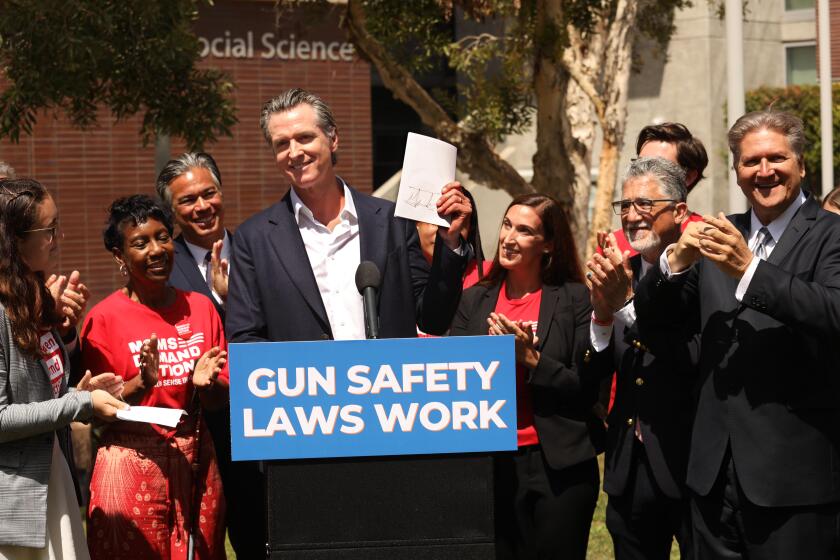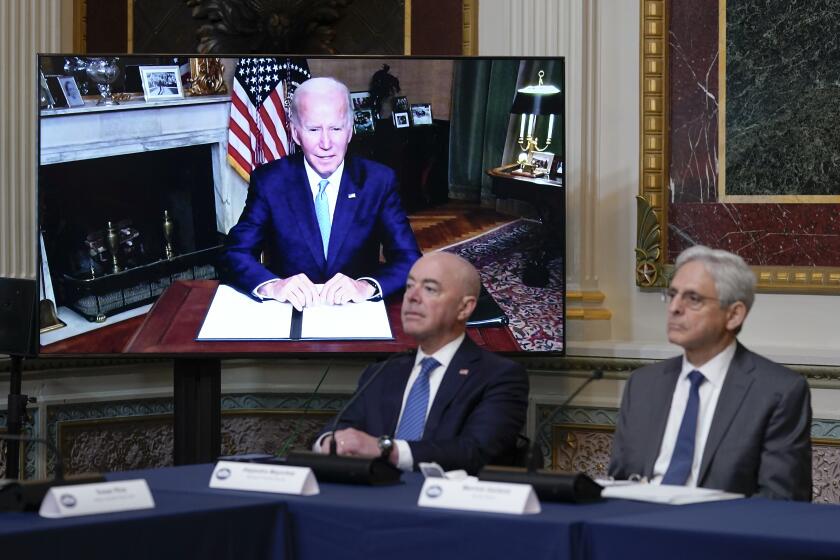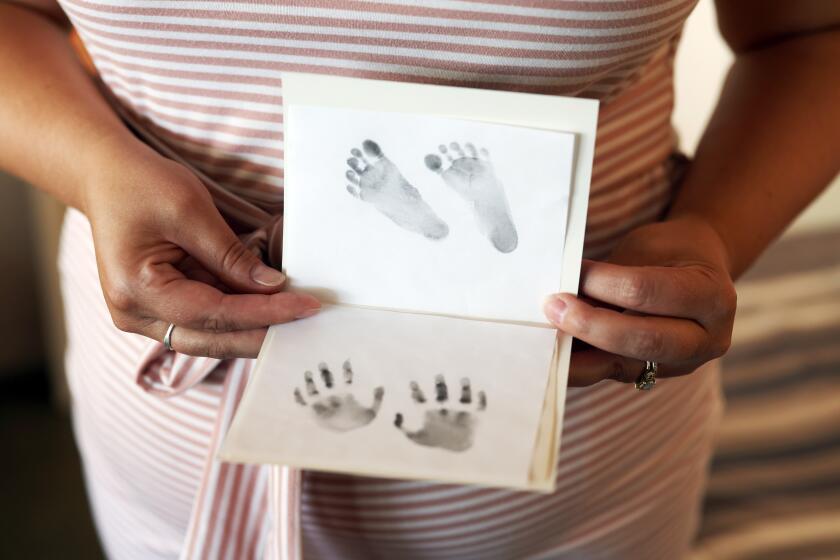Low-wage workers bear financial brunt of denied abortions, research shows

- Share via
A Texas mother of a toddler, her family scraping by on her husband’s income, was desperate to return to work but struggling to afford child care. A young Florida warehouse worker had barely left behind a turbulent past of homelessness and abuse only to be mired in debt.
When both women learned they were pregnant, they came to the agonizing conclusion that they couldn’t go through with it.
“When you try to discuss the alternatives, you find the problems. If we could do this, where is the baby going to stay?” said Alyssa Burns, the warehouse worker who makes $16 an hour and was sharing a two-bedroom apartment with her boyfriend and another couple when she found out she was pregnant last year. “We both work full-time jobs. My mom works. We can’t afford child care.”
There are wide-ranging reasons why women may seek to terminate their pregnancies, but for those struggling to make ends meet, finances are inevitably part of the calculation. Now many of them will be thrust into a circumstance they can’t afford as abortion bans and restrictions take hold in half the country after the Supreme Court overturned the 1973 Roe vs. Wade ruling guaranteeing abortion rights.
Three-quarters of women who seek abortions were low-income, meaning they had a family income below or up to double the federal poverty level, according to a 2014 study by the Guttmacher Institute, a research group that supports abortion rights. More than half already had children and many worked in physically demanding jobs with fewer labor protections and less flexibility than higher-wage positions.
“A salaried employee with benefits is the type of person who generally does find a way [to make ends meet] with or without their employer support,” said Caitlin Myers, an economist at Middlebury College who studies reproduction and the economy. “We are talking about a really economically fragile group of workers, often hourly workers, often shift workers with very unpredictable schedules, for whom this becomes really overwhelming.”
The California governor signed a gun control bill Friday that mimics Texas’ abortion ban. He also unveiled an ad targeting Texas Gov. Greg Abbott.
Burns, 24, was able to swiftly end her just over 6-week-old pregnancy in March 2021 because Florida had no law against it at the time. The state’s current law bans most abortions after 15 weeks. But she said she is haunted by the idea that in a different state and a different time, she might have been forced to have the baby.
The Texas mother panicked at the same possibility. She learned she was pregnant in September of last year just as a Texas law banning all abortions after roughly six weeks of pregnancy took effect.
“I was so broken. I couldn’t fathom that it was happening,” said the 30-year-old hairstylist who, like Burns, shared her story through the advocacy group MomsRising but requested anonymity for fear of facing harassment in her conservative Corpus Christi community. “I can’t afford this child. I am struggling with a child I already have.”
In the end, she was able to have an abortion in New Mexico with financial help from Planned Parenthood. Even so, she and her husband incurred $1,000 in expenses, including $500 in car rental costs. Her husband had to take unpaid time off from his job as a cellphone tower maintenance worker.
If it hadn’t been for the Texas ban, she said, she could have gone to a clinic 20 minutes away. Indeed, for many women living in states that would ban abortions, the average travel distance to the nearest clinic would rise from 35 miles to 272 miles, according to Myers’ analysis of a national database of abortion facilities, revised monthly.
President Biden has signed an executive order aimed in part at making it easier for women seeking abortions to travel between states to obtain access to the procedure.
Many abortion rights opponents say the answer is not to make it easier to terminate a pregnancy but to widen the safety net and make it easier to have children. They argue that Roe vs. Wade hurt working women by discouraging employers and the government from enacting more generous benefits for parents.
“Abortion has been the privileged response to female poverty and the plight of low-wage workers in this country,” said Erika Bachiochi, an anti-abortion rights legal scholar who believes more pressure should be applied on conservative states to strengthen policies around parental leave and child care.
But research tells a different story. Carrying an unwanted pregnancy quadruples the odds that a woman and her child will live below the federal poverty line, according to the Turnaway Study, a UC San Francisco research project that tracked women who had access to abortions and compared them to women who’d been denied them over a 10-year period. And it triples the chances of the woman being unemployed, the study found
Being denied an abortion often leads to increased rates of unpaid debt, poverty, evictions and bankruptcies over the next five years, according to a recent study published by the National Bureau of Economic Research, which used the Turnaway study data to examine the credit histories of women who couldn’t get abortions.
Those were some of the risks facing Burns, who left home at 18 and finished high school while living homeless. Although she had found some stability by the time she got pregnant, she was still paying off more than $7,000 in debt from breaking her rental lease a few years earlier when she left an abusive relationship.
Earlier this year, the Texas hairstylist moved in with her parents in Corpus Christi because life had become too expensive in Austin, where her monthly rent rose from $1,400 to $1,600 and putting her daughter in child care would have cost $600 a week. Her husband, who earns $50,000 a year with overtime, will join her once their lease term ends. With their parents able to watch her child, she was able to go back to work two days a week.
California may be an abortion sanctuary, but some women have to leave the state for the procedure.
“We’ve been playing catch-up for the longest time,” she said.
Catherine R. Pakaluk, an abortion rights opponent and assistant professor of social research and economic thought at the Catholic University of America, acknowledges the unique difficulties for low-income women but does not believe abortion is the right answer.
“Having a baby is harder when you’re poor. But I don’t think the poor’s interest or the elite’s interest are served by eliminating a child conceived into difficult circumstances,” Pakaluk said. “That’s why the poor should be 100% the focus of any kind of policymaking.”
In reality, however, states with some of the nation’s strictest abortion laws are among the hardest places to raise children, especially for the poor, according to an analysis of federal data by the Associated Press.
In Mississippi, for instance, access to pre- and postnatal care has dwindled since the Supreme Court ruling in June, making childbirth even more dangerous for poor women and children.
There is also a big disparity between the benefits that employers offer low-income workers versus high-income workers.
Roughly 6% of private industry workers with an average wage in the lowest 10% had access to paid family leave, compared with 43% workers in the top 10%, according to the most recent survey by the U.S. Bureau of Labor Statistics, conducted last year.
And only 38% of private industry workers with wages at the bottom 10% get paid sick leave, compared with 96% in the top 10%, according to a Labor Department study done in March.
Burns said she and her boyfriend dream of eventually having a family, but they need stability first. She has been able to go to the dentist for the first time in her life, getting cavities filled, wisdom teeth removed and some crowns put in, accruing more debt that would have been difficult to handle with a baby.
“We have spent the last year and a half trying to get our financial stuff together and trying to get our health together, trying to get to the point where we could probably do it and not damage the child with our own problems,” Burns said.
More to Read
Sign up for Essential California
The most important California stories and recommendations in your inbox every morning.
You may occasionally receive promotional content from the Los Angeles Times.













